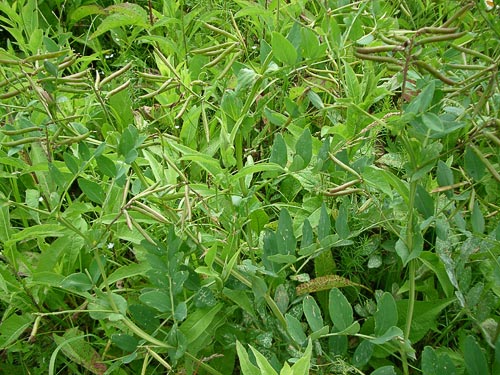Relatives
Lathyrus pisiformis L. - Pisiform grass pea.
Taxonomic position.
Family Fabaceae Lindl., genus Lathyrus L.Morphology and biology.
Perennial plant, 50-100 cm in height, with a long, branchy root. Stems slightly cling with the help of short cirri; stems are almost upright. Stipules are large, 20-50 mm in length, 8-18 mm in width, ovate, with lengthened top and denticles at the base. Leaves are bluish green below, usually consisting of 4-6 pairs of ovate or oval leaflets, 25-50 mm in length, 10-30 mm in width. The leaf axis culminates in a short cirrus. Racemes are shorter than leaves, with 8-15 flowers. Flowers are medium-sized, 10-15 mm in length, red-lilac. Pedicels are shorter than the calyx. Calyx is short and tubular, thickening slightly at the base; its denticles are triangular. Flag is round-elliptical with dark mesh veins and dredging on top, on wide stem. Wings are oblong-lanceolate. Keel is bent almost at a right angle to the bottom edge. Pods are linear, slightly compressed from the sides, 40-50 mm in length, 4-5 mm in width. Valves of pods are dark brown. Seeds are almost spherical, brown; there are 10-12 seeds in a pod. Hilum length is equal to 1/6 the circumference of the seed. Chromosome number: 2n=14. Blossoms in May; fructifies in June.Distribution.
The general distribution area includes Central Europe and the Dzhungarsko-Kashgarsky area. Within the former USSR, the species occurs in all areas of the European part (except for Karelo-Lappish, Lower Volga and the Crimea), the Caucasus (Ciscaucasia), Western Siberia (Obsky, Irtyshsky Upper-Tobolsky regions, Altai area), Eastern Siberia (Yenisejsky, Angaro-Sajansky areas), and Central Asia (Aralo-Caspian, Pribalhashsky, Tjan-Shansky areas).Ecology.
Occurs in mixed woods and among bushes. Rarely occurs in steppe meadows.Use and economic value.
It is a fodder plant of rather high quality; is well-eaten by large, horned livestock and horses in the form of hay. In pastures well, too.References:
Cherepanov S.K. 1995. Plantae Vasculares Rossicae et Civitatum Collimitanearum (in limicis USSR olim). St. Petersburg, Mir I Semia, 990 p. (in Russian).Grossgeim A.A. 1952. Flora of the Caucasus. Vol. 5. Moscow-Leningrad: Publishing House of the USSR Academy of Sciences, 424 p. (in Russian).
Hulten E., Fries M. 1986. Atlas of Northern European Vascular Plants North of the Tropic of Cancer. Vol. 1-3. Koeltz Scientific Books, Konigstein.
Malyshev L.I., Peshkova G.A., eds. 1979. Flora of Central Siberia. Vol. 2. Novosibirsk: Nauka, p. 638. (in Russian).
Shishkin B.K., ed. 1958. Flora of the USSR. Vol. 23. M.-L.: Publishing House of Acad. Science, pp. 524-525. (in Russian).
Tolmachev A.I., ed. 1976. Flora of the Northeastern European part of the USSR. Vol. 3. Leningrad: Nauka, 293 pp. (in Russian).
Tsvelev, N.N. 2000. Manual of the Vascular Plants of Northwestern Russia (Leningrad, Pskov and Novgorod district). St. Petersburg: Publishing House of SPHFA, p. 511. (in Russian).
© T.N. Smekalova


